Laser Distance Measurer: Difference between revisions
No edit summary |
|||
| Line 1: | Line 1: | ||
{{Short description|Laser distance measurement using time‐of‐flight}} | {{Short description|Laser distance measurement using time‐of‐flight}} | ||
==1 Group Members== | ==1 Group Members== | ||
Arya Chowdhury, Liu Sijin, Jonathan Wong | Arya Chowdhury, Liu Sijin, Jonathan Wong | ||
Revision as of 15:11, 28 April 2025
1 Group Members
Arya Chowdhury, Liu Sijin, Jonathan Wong
2 Background and Theory
3 Equipment List
- Oscilloscope
- Function generator (Tektronix AFG1022) for LED
- Keithley 2231A-30-3 DC power supply for photodetector
- Hamamatsu S5971 silicon photodiode
- Translation stage
- Optical breadboard, postholders and screws
- Meter ruler
- BNC cables
4 Experimental Work
4.1 Procedure
4.1.1 Laser Modulation and System Initialisation
Configure the function generator (Tektronix AFG1022) to output a 10 MHz square wave with an amplitude of 0–3.1 V (High level: 3.1 V, Low level: 1.0 V, output impedance: 50 Ω) to modulate the laser diode. Use the Keithley 2231A-30-3 DC power supply to provide 5.0 V to the laser driver circuit, with a current limit of 30 mA. Verify the laser beam stability to avoid multimode noise or thermal drift that could distort the modulation waveform.
4.1.2 Optical Alignment
Mount the 650 nm laser diode and use an aspheric lens to collimate and focus the beam onto the reflective target surface.

|
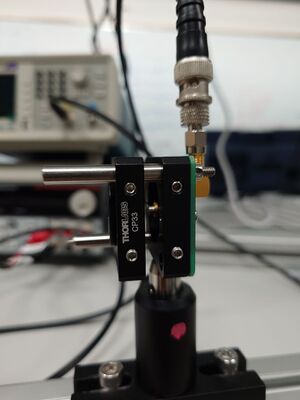
|
| Figure 2. Front view of collimating lens for laser diode | Figure 3. Side view of collimating lens for laser diode |
4.1.3 Detection and Amplification Circuit Configuration
For the photodetector, a Hamamatsu S5971 silicon photodiode was used to detect the reflected light signal. To amplify the signal linearly without saturation, connect the detector output to a matched high-speed preamplifier (bandwidth >100 MHz, gain ∼10³–10⁵). Connect the amplifier output to Channel 2 of a digital oscilloscope; connect the reference signal from the function generator to Channel 1 as the modulation phase reference.

|
| Figure 4. Hamamatsu S5971 silicon photodiode with amplifier |
4.1.4 Time Delay vs. Distance Mapping
Fix the LED source and the photodetector on a linear translation stage, ensuring proper alignment for the beam return to the detector at all positions along the translation stage; the detector and the laser diode were mounted on a postholder so that the height of the detectors was adjustable. Turn on the LED and ensure that the beam is collimated by adjusting the distance of the lens to the LED. Incident the LED onto the photodetector and observe the function generated on the oscilloscope. Use the oscilloscope’s cursor measurement function to determine the relative time delay Δt between the modulation reference signal (Channel 1) and the return signal (Channel 2). Correlate the measured delay values with corresponding distances to establish the system’s delay–distance response curve. The following are the steps carried out to measure the time delay and the corresponding distance:
- Fix the LED source and the photodetector on a linear translation stage, ensuring proper alignment for the beam return to the detector at all positions along the translation stage; the detector and the laser diode were mounted on a postholder so that the height of the detectors was adjustable.
- Use a meter ruler to mark the distance along the translation stage.
- Move the LED source to the marked positions (e.g. 30 cm from detector) and adjust the beam until it is centralised on the photodetector.
- Measure the time delay on the oscilloscope. Record the minimum, maximum and mean time delay—take three readings per distance and average them.
- Repeat steps 1–4 for different distances on the translation stage.
- Insert a mirror in the setup to act as the “object we are trying to measure the distance of”, so that the beam path is reflected off the mirror to the photodetector.
- Measure the total path length manually and repeat steps 1–4 for each mirror position.

|
| Figure 5. Measurement experimental setup without mirror: LED and photodetector on translation stage. |
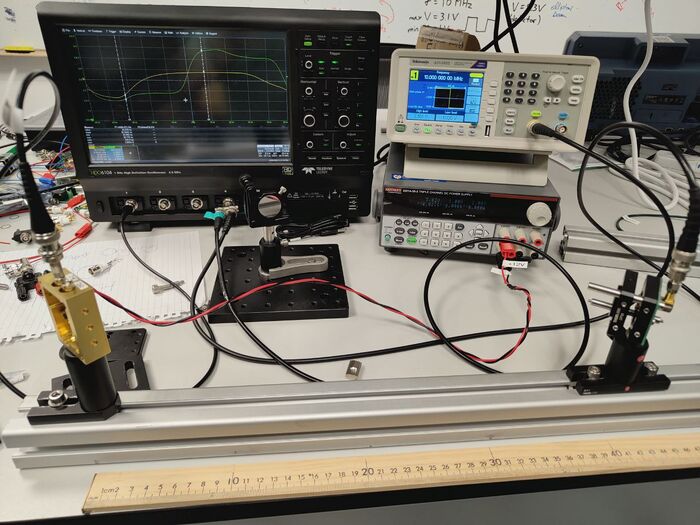
|
| Figure 6. Measurement experimental setup with mirror acting as the “object.” |
5 Results
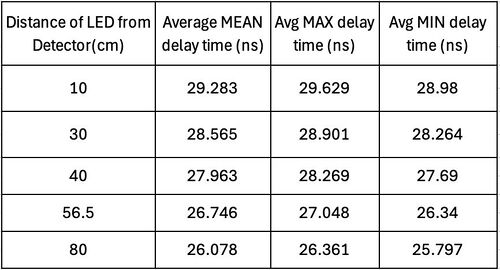
|
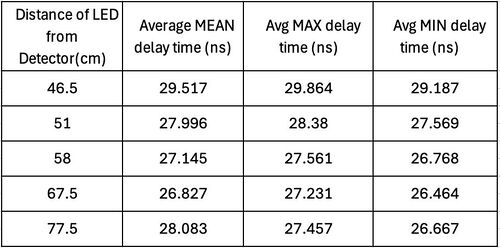
|
| Table 2. Measured delay time vs manually measured distance with mirror acting as the “object.” |
The measured delay time is in the order of 20–30 nanoseconds, which, when calculated, gives about 6–9 m of distance… [text unchanged]
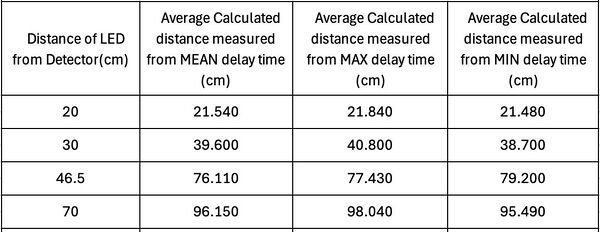
|

|
| Table 4. Calculated average distance with mirror as the “object.” |
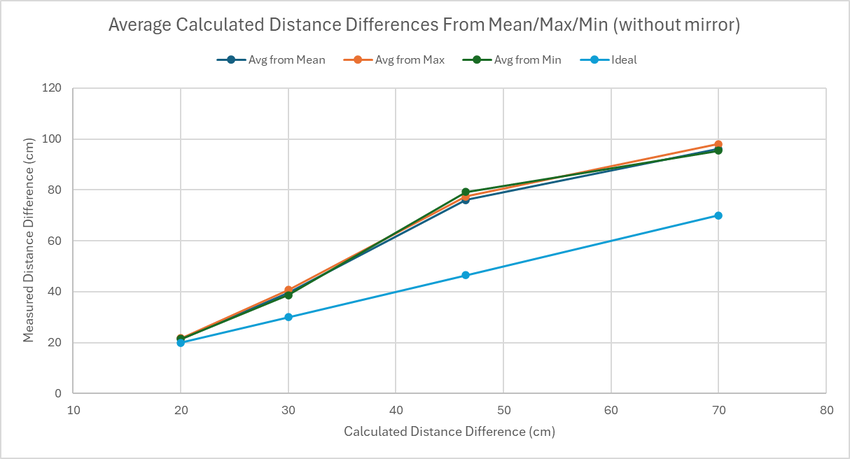
|
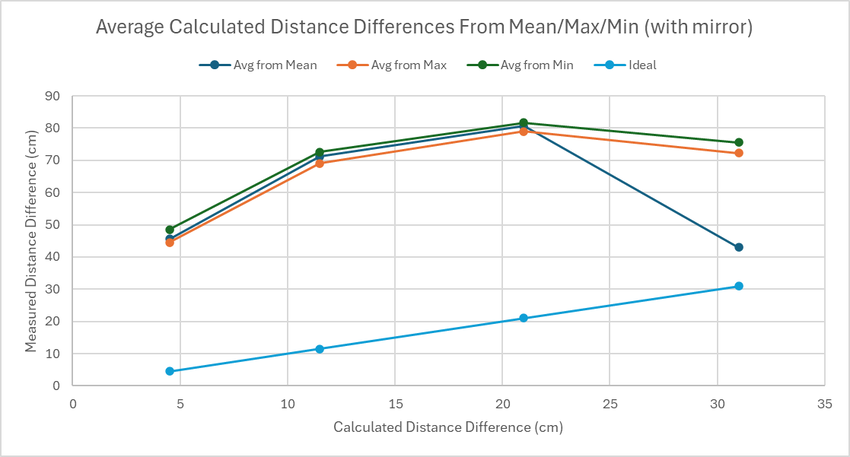
|
| Figure 7. Graph of calculated distance vs manually measured distance without mirror. | Figure 8. Graph of calculated distance vs manually measured distance with mirror. |
6 Challenges and Conclusion
- One of the challenges we faced was centring the beam onto the photodetector…
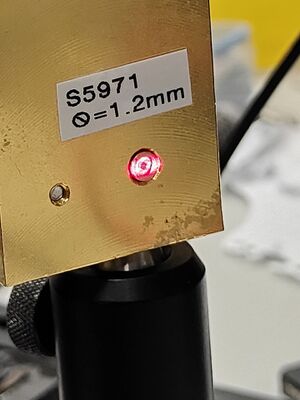
|
| Figure 9. Beam spot on photodetector |
- To have accurate distance measurements in the centimetre regime …
7 Improvements and Future Work
- Install a focusing lens for the photodetector
- Use a bandpass filter at 650 nm laser to filter out other frequencies to get less fluctuations in the delay time reading on the oscilloscope.